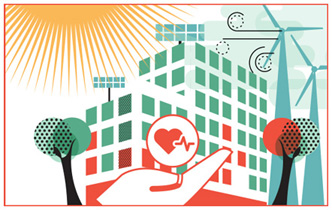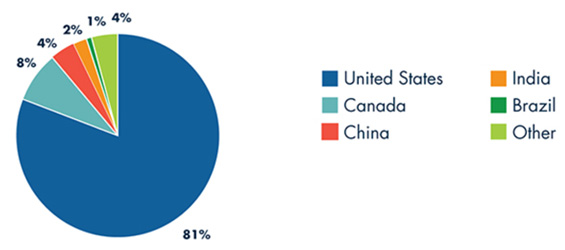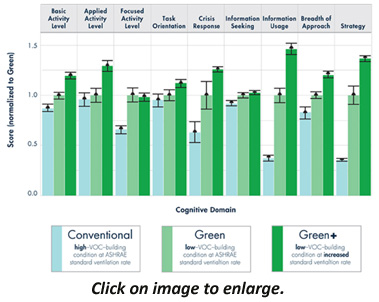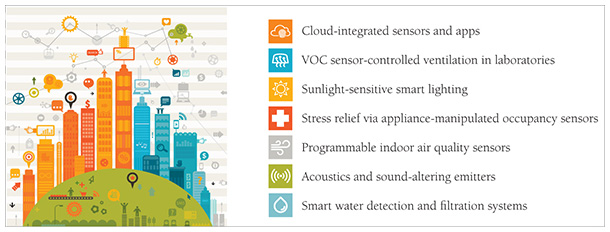 The following article by Greg Powell, Elizabeth Bowen, and Marvin Roeder originally appeared in the December issue of FMI Quarterly, a publication for clients of FMI Corporation.
The following article by Greg Powell, Elizabeth Bowen, and Marvin Roeder originally appeared in the December issue of FMI Quarterly, a publication for clients of FMI Corporation.
In the short video introduction below, Greg Powell explains the purpose of the article. He says, “After talking to a range of project stakeholders and analyzing current trends, we find that prevailing thinking is going beyond the carbon footprint of a building – or its energy efficiency – to include the health of the occupants inside the building – or the wellness factor.” Reprinted with permission.
Health and Wellness: The Next Disruption in Sustainable Building Design from FMI Corporation on Vimeo.
In today’s global economy, building owners and employers are looking for ways to compete for talent, reduce operating costs and benefit the environment. While Leadership in Energy and Environmental Design (LEED) certification continues to be the leader in U.S. commercial real estate sustainability certification market share, trends in the market are causing building owners and employers to consider new aspects of sustainability, new certification systems and new technologies.
Millennials have now surpassed Generation X to become the largest generation in the American workforce. This group’s preferences for sustainability, wellness and business transparency are expected to be major influences on building design. This trend creates significant opportunities for architecture, engineering and construction (A/E/C) firms well-positioned to meet this generation’s demand for all things green, healthy and innovative.
LEED Reigns in A/E/C
 The most prevalent green building rating system in the world, LEED is used in over 165 countries and territories. Expanded to serve practically all building, community and home project types, this certification addresses both human and environmental health, primarily by rating various components of a building’s design and construction. However, there are varying tradeoffs with LEED’s holistic human and environmental strategy. Among them is the inherent challenge that comes with engineering a building to bring in more outside air for improved human health without compromising energy efficiency goals.
The most prevalent green building rating system in the world, LEED is used in over 165 countries and territories. Expanded to serve practically all building, community and home project types, this certification addresses both human and environmental health, primarily by rating various components of a building’s design and construction. However, there are varying tradeoffs with LEED’s holistic human and environmental strategy. Among them is the inherent challenge that comes with engineering a building to bring in more outside air for improved human health without compromising energy efficiency goals.
LEED continues to dominate the green building certification market and appears to have as many as 65,000 projects in the pipeline for the next few years. As shown in the graph above, LEED adoption rates have grown consistently over the last  15 years; as of July 2017, there were 90,900 total commercial LEED certifications. The larger number of LEED registrations serves as a proxy for anticipated future growth in LEED certification and sustainable design. (Image source: Country Market Brief.)
15 years; as of July 2017, there were 90,900 total commercial LEED certifications. The larger number of LEED registrations serves as a proxy for anticipated future growth in LEED certification and sustainable design. (Image source: Country Market Brief.)
While the U.S. is by far the most active country in the world for LEED certifications, it’s by no means the only supporter of green building. Many global markets are pursuing widespread measures to reduce carbon footprints and maximize energy efficiency. China, Canada and India, for example, are all increasing adoption of green building standards. (Image source: Country Market Brief.)
Growing Diversification in Sustainability Measurements
LEED has responded to the trends in transparency, wellness and technology with the addition of a new Performance Path to LEED certification using Arc, which allows building owners or consultants to collect energy, water, waste, air quality, occupant satisfaction and transportation data to benchmark themselves against other projects. This level of benchmarking helps to improve overall building performance. Arc can be used both to recertify LEED certified buildings and to certify non-LEED buildings. The program uses data from occupant satisfaction and other key performance indicators to influence a daily or monthly dynamic LEED score.
Over the past two decades, many new green building certification programs have emerged with and without LEED alignment. Some are geographically focused, such as BREEAM, which dominates the U.K. market. Others are focused on a sector or issue that LEED does not specifically address, such as Living Building/Zero Energy Certification, Passive House and Green Globes, all of which have shown rapid adoption rates, but still with far fewer certifications in place compared to LEED.
The Next Phase in the Evolution of Sustainable Design
We’re now witnessing the increased convergence of green and wellness. While green certifications such as LEED focus more on the environmental impact of a building, wellness rating systems emphasize the health and well-being of the building’s occupants. According to Leigh Stringer, EYP, workplace strategist and author of “The Healthy Workplace,” “Many of the strategies for creating a healthy and productive physical work environment stem from the efforts to make buildings greener or more environmentally friendly.”
This progression is driven by, in part, a growing focus among employers on health costs as U.S. health care expenses spiral out of control. Studies have shown that the building environments affect human physiological systems. Americans spend more than 90% of their time indoors, on average, yet indoor air is generally two to five times more toxic than outside air due to poor ventilation and off-gassing of toxic chemicals from a host of products, from carpeting to furniture. The Harvard T.H. Chan School of Public Health identified these nine foundations of a healthy building: air quality, thermal health, moisture, dust and pests, safety and security, water quality, noise, lighting and views, and ventilation.
The Reengineering of the Design and Construction Industry: Getting Your Organization Ready For Change
 The benefits of “healthy buildings” have been documented in numerous studies and include reduced illness and absenteeism among workers, higher worker productivity, higher test scores among students and greater workplace satisfaction. One such study directly quantified the impact of indoor environmental quality on cognitive functions. By changing levels of air ventilation, carbon dioxide and volatile organic compounds, the study measured how the indoor environment in which we work and live affects our health and productivity. The results show a clear correlation between improved indoor air quality and cognitive performance. (Source for image on left: Environ Health Perspect.)
The benefits of “healthy buildings” have been documented in numerous studies and include reduced illness and absenteeism among workers, higher worker productivity, higher test scores among students and greater workplace satisfaction. One such study directly quantified the impact of indoor environmental quality on cognitive functions. By changing levels of air ventilation, carbon dioxide and volatile organic compounds, the study measured how the indoor environment in which we work and live affects our health and productivity. The results show a clear correlation between improved indoor air quality and cognitive performance. (Source for image on left: Environ Health Perspect.)
These cognitive benefits translate into documented monetary cost savings for building owners and employers. In turn, building certification standards are evolving to hold designers and contractors accountable to deliver these cost-reducing and revenue-boosting benefits. However, a survey conducted by Virgin HealthMiles Inc. illustrates some of the challenges with wellness initiatives: 89% of employees reported a company’s health benefits as significant to their choice of employer, but only 36% of employers reported having the information needed to be able to make actionable decisions about an employee health strategy.
Partly in response to the financial potential in addressing occupant health in the built environment, industry stakeholders developed the WELL Building Standard, which integrates health, design and management. According to the International WELL Building Institute, 90% of the costs associated with the life cycle of a commercial building come from the people inside (salaries and benefits), while only 10% come from operating the building itself. Wellness certifications have emerged to improve returns on the 90% invested in human assets. As Rachel Gutter, senior vice president of the WELL Building Institute, explained to FMI, “Our indoor environments have a profound effect on our health and wellness, impacting everything from our stress levels to alertness to productivity. The WELL Building Standard was developed with this relationship in mind. Designed to be as interactive as possible and to work in harmony with other building certifications like LEED, WELL encompasses over 100 features addressing seven core concepts of building performance that have been scientifically proven to impact the occupant experience.”
It’s important to note that WELL certification is not the only certification gaining a significant amount of attention in the market. “A new wellness program, the Facility Innovations Toward Wellness Environment Leadership (Fitwel) certification program, was developed by the Center for Disease Control (CDC) and was piloted on General Services Administration buildings, an organization also known for its early adoption of LEED certification,” Stringer explains. “Many of my clients are adopting Fitwel as a certification tool because the strategies have been vetted by CDC’s research team and are intentionally low-cost and fairly easy to implement, even in existing buildings.”
Wellness Implications
Wellness standards have yet to achieve broad market adoption, with 28 WELL certified buildings and 159 Fitwel buildings currently operating in the U.S. However, it’s clear that human health and wellness in the workplace are both high priorities for millennials, and more certifications are on the way. In the U.S. alone, there are currently 224 registered projects. Worldwide, 522 projects are registered for WELL certification. Studies show that millennials are increasingly emphasizing a healthy work environment when making employment decisions. Rising demand for human wellness-focused work environments among this most influential component of our workforce is leading more companies to respond by considering wellness certifications in both new and existing buildings. Architects are beginning to witness this uptick in building owner and employer interest in wellness. Maria Papiez, sustainability leader at design firm EwingCole, notes “There is now a critical mass for wellness in the marketplace as big brands compete for talent.” One such brand is technology leader Lenovo. “To attract today’s top talent, Lenovo committed to both LEED Platinum and WELL certification for its new building at the North American Lenovo headquarters,” explained Erin Bolduc, Lenovo technical project manager. “We pursued WELL late in the design process as we recognized a significant amount of overlap between the two rating systems while pursuing LEED v3. Where LEED and WELL did not overlap, Lenovo corporate policies made it obvious that, with our benefits and the site characteristics, we would be able to achieve WELL certification.”
One such brand is technology leader Lenovo. “To attract today’s top talent, Lenovo committed to both LEED Platinum and WELL certification for its new building at the North American Lenovo headquarters,” explained Erin Bolduc, Lenovo technical project manager. “We pursued WELL late in the design process as we recognized a significant amount of overlap between the two rating systems while pursuing LEED v3. Where LEED and WELL did not overlap, Lenovo corporate policies made it obvious that, with our benefits and the site characteristics, we would be able to achieve WELL certification.”
In addition, the demand for wellness and “healthy buildings” has driven – and continues to drive – advancement in building innovation and technologies that monitor and enhance health benefits for building occupants, as illustrated in the chart to the right. Technological innovation has a rapidly growing influence on the broader design and construction industry, and its role in fostering healthy building environments is growing in equal measure.
In time, buildings that achieve wellness certifications may earn health insurance incentives, as insurance providers continue to explore ways to reduce risk. Companies pursuing less formal employee health and wellness initiatives – such as lifestyle and disease management programs – have accrued similar benefits.
Impact on the Design Industry Moving Forward
When sustainability became the new normal, designers adapted to the demand for LEED and similar capabilities. Building stakeholders are now broadening this environmental focus toward the human experience, and the industry must once again adapt.
As the convergence of green and wellness continues to gain momentum, the design industry will be facing new demands. To deal with these shifts, firms will need to address the various wellness programs gaining in prominence; navigate new and emerging building technologies; and cater to shifting priorities among building owners, employers and employees. As these demands grow, design firms will also need the right balance of talent and capabilities to compete and thrive in this evolving environment.


